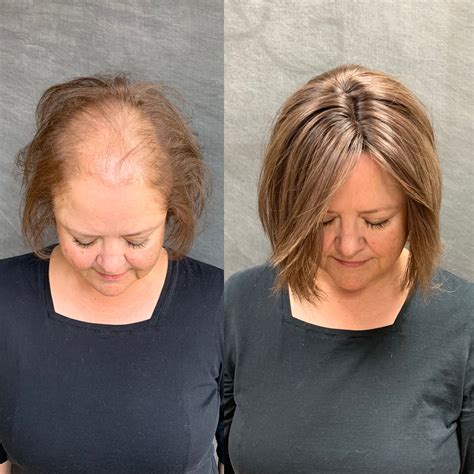Addressing the Common Concern of Hair Loss for African American Women

Hair loss is a prevalent issue that affects millions of African American women, leaving them feeling self-conscious and searching for effective solutions. According to the American Academy of Dermatology, approximately 50% of African American women experience some degree of hair loss by the age of 50. This is primarily attributed to factors such as genetics, hormonal changes, and certain hairstyles that may put excessive tension on the hair.
Understanding the Causes and Impact of Hair Loss
Hair loss, also known as alopecia, can manifest in various forms, including thinning hair, receding hairlines, bald spots, and complete hair loss. It can be triggered by several factors, including:
- Genetics: African Americans are more prone to a condition called central centrifugal cicatricial alopecia (CCCA), which is characterized by scarring and permanent hair loss on the scalp.
- Hormonal Changes: Fluctuations in hormone levels, particularly during pregnancy, childbirth, menopause, and thyroid issues, can lead to temporary or permanent hair loss.
- Hairstyles: Hairstyles that involve tight braids, weaves, or extensions can cause traction alopecia, a condition where hair follicles are damaged due to excessive pulling.
- Medical Conditions: Certain autoimmune diseases, such as lupus and alopecia areata, as well as infections or scalp disorders, can also lead to hair loss.
African American Hair Toppers: A Non-Surgical Solution
For African American women seeking a discreet and effective solution to thinning crowns, hair toppers have emerged as a popular choice. Hair toppers are non-surgical hairpieces designed to blend seamlessly with natural hair, providing instant volume and coverage.
Why African American Hair Toppers Matter
- Confidence Boost: Hair toppers empower African American women by restoring their hair’s fullness and volume, enhancing their self-esteem.
- Versatile Styling: Hair toppers allow for versatile styling options, enabling women to experiment with different looks and regain confidence in their appearance.
- Long-Lasting Investment: Made with high-quality materials, hair toppers can last for an extended period, providing a cost-effective solution compared to surgical hair restoration procedures.
- Non-Invasive and Customizable: Hair toppers are non-invasive and customizable to match an individual’s hair texture, color, and density, ensuring a natural-looking result.
Effective Strategies for Choosing and Wearing Hair Toppers
- Consultation and Evaluation: Seek professional advice from a licensed hair care specialist or trichologist to determine the most suitable hair topper for your specific needs.
- Texture and Color Matching: Choose a hair topper that closely matches your natural hair texture and color to achieve an undetectable blend.
- Secure Attachment: Ensure that the hair topper is securely attached, using clips, combs, or an adhesive solution, to prevent it from slipping or shifting.
- Maintenance and Care: Follow proper care and maintenance instructions to extend the lifespan of your hair topper, which may include regular brushing, conditioning, and professional cleaning.
Benefits of Using African American Hair Toppers
- Immediate Results: Hair toppers provide instant volume and coverage, transforming the appearance of thinning crowns.
- Concealment of Thinning: They effectively conceal areas of hair loss, creating a fuller and more youthful look.
- Versatility and Flexibility: Hair toppers offer styling flexibility, allowing women to experiment with different hairstyles and regain a sense of control over their appearance.
- Improved Quality of Life: By addressing the emotional and psychological toll of hair loss, hair toppers enhance well-being and quality of life.
Table 1: Types of Hair Toppers for African American Women
| Type | Description |
|---|---|
| Clip-In | Attaches to existing hair using small, inconspicuous clips |
| Lace Front | Creates the illusion of a natural hairline using a delicate lace base |
| Monofilament | Provides a more natural-looking scalp simulation, with hair strands individually knotted onto a sheer fabric |
| Full Cap | Covers the entire head, offering maximum coverage and versatility |
Table 2: Tips for Choosing the Right African American Hair Topper
| Factor | Considerations |
|---|---|
| Texture | Match the texture to your natural hair for a seamless blend |
| Color | Choose a color that complements your skin tone and hair shade |
| Size | Select a topper that covers the area of thinning adequately |
| Attachment Type | Consider your individual preferences and lifestyle |
| Maintenance | Determine the level of maintenance required and choose a topper that suits your routine |
Table 3: Pros and Cons of African American Hair Toppers
| Pros | Cons |
|---|---|
| Instant volume and coverage | Requires maintenance and care |
| Conceals thinning crowns | May be noticeable if not properly attached |
| Enhances self-esteem | Can be expensive |
| Non-surgical solution | May not be suitable for all types of hair loss |
Table 4: Pain Points and Motivations for Using African American Hair Toppers
| Pain Points | Motivations |
|---|---|
| Hair loss and thinning | Regain confidence |
| Lack of volume | Enhance appearance |
| Concealment of bald spots | Improve well-being |
| Desire for versatility | Experiment with different hairstyles |
| Non-surgical solution | Avoid invasive procedures |
Conclusion
African American hair toppers offer a revolutionary solution for women struggling with thinning crowns. By blending seamlessly with natural hair, these non-surgical hairpieces provide instant volume, coverage, and versatility. Embracing the use of hair toppers empowers African American women, enhances their confidence, and restores their sense of beauty and self-worth.
